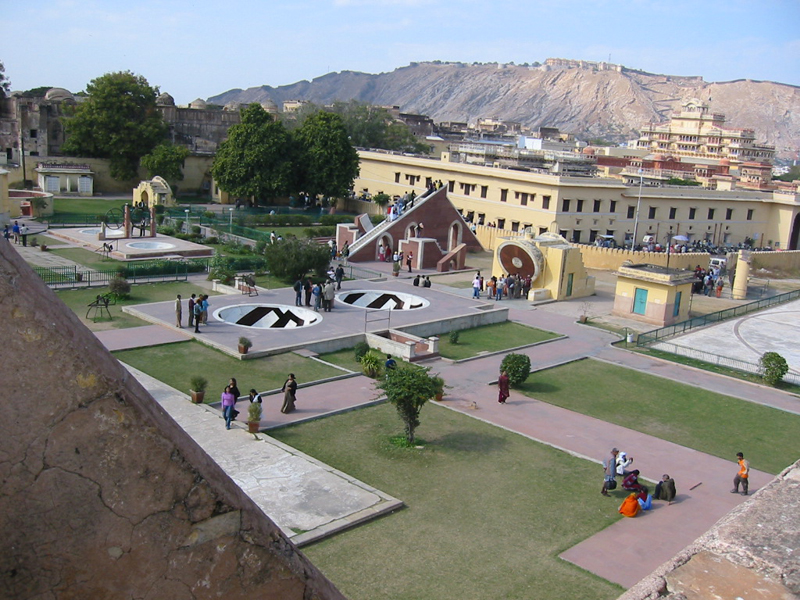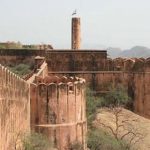Jantar Mantar
Built in – 1728-1734
Built by – Maharaja Jai Singh II
Location – Near City Palace, Tripolia Bazar, Jaipur, Rajasthan
Renovated By – Major Arthur Garrett
Highlight – Listed on UNESCO World Heritage List
Managed by – Government of Rajasthan
Timings to Visit – 9:00am to 4:30am (Open on all days)
Jantar Mantar is one of the largest observatories in the world, humankind has ever built. It is a perfect combination of religion, science and art. Jantar Mantar is a series of five magnificent structures built in Jaipur, New Delhi, Ujjan, Varanasi and Mathura. It was structured during the reign of Maharaja Jai Singh II in the 1720’s. The magnificent structure in Jaipur is considered to be the largest of the five observatories. It also shelters the largest sundial in the world. Curiosity of mankind about the Universe and the Cosmos motivated Maharaja Jai Singh II to build an astronomical observatory. ‘Jantar Mantar’ is derived from the Sanskrit terms ‘Yantra’ and ‘Mantra’. ‘Yantra’ means ‘instruments’ and ‘formula’ means ‘Mantra’ respectively. However, the term ‘Yantra’ was replaced with ‘Jantar’ meaning ‘magical’. The Jantar Mantar is also famous among the astronomers, historians and architects around the world of its huge architectural and astrological instruments.
History of Jantar Mantar
The founder of Jaipur, Maharaja Jai Singh II is recorded as a great scholar and avid astrologer in history. He had a very good hold in philosophy, astrology, architecture and religion and was also well versed with universal mathematical concepts of Euclid’s Clements, Ptolemy’s Syntaxes and the Master works of Aryabhatta. In the year 1718 he came up with an idea of constructing an observatory during his reign. He studied astronomy and successfully built five different observatories around North India. It is believed that Maharaja Jai Singh II used to sit with other scholarly astronomers like Pt. Kedarnath for astronomical observations in these observatories. The ‘Jantar Mantar’ at Jaipur is the biggest conservatory in the country. It has been renovated from time to time to protect the various instruments present to calculate the precise measurements of time, the azimuth, declination of the sun and the positions of constellations, along with several other astronomical phenomena. Unfortunately though, the Jaipur observatory was functional for seven years only because of the failure of the Maharaja in deriving accurate astronomical observations.
Architecture: Jantar Mantar
The whole of the astronomical observatory is included of fourteen major geometric devices that are used for measuring time, tracking constellations and observing the orbits around the sun. Some of the most popular structures within the Jantar Mantar include the ‘Samrat Yantra’ which happens to be the world’s largest sundial, the ‘Hindu Chhatri’, the ‘Jaiprakash Yantra’ and various other geometric structures with astronomical devices to explore the mystic universe. Hence this intriguing structure is a must see in Jaipur.
Beautiful Light and Sound show of Jantar Mantar, Jaipur
The eye treating light and sound show of Jantar Mantar in Jaipur is performed without live actors. It covers the story of Amber Fort & Jaipur dynasty with the most spectacular music and sound effects.
For more Details and Information visit: Light and Sound show of Jantar Mantar
Tourist Attractions Nearby
- Jaipur City Palace
- Jaigarh Fort
- Galta Monkey Temple
Jantar Mantar Photography charges
- For Indian: Rs. 50.00
- For Foreigner: Rs. 50.00
Jantar Mantar Entry Fee
- For Indian: Rs. 40.00
- For Foreigner: Rs. 200.00
Images of Jantar Mantar Jaipur
Trending Search Topics:
-
Best Place to look for PG in Jaipur for Students and Working Professionals
-
Tiffin Services In Jaipur & Healthy Home Food Cloud Kitchen
-
Where to buy the Best Designer Indian Sarees when Visiting Jaipur
-
Best Gynecologists and Maternity Hospitals in Jaipur
-
Personalized Gifts in Jaipur, Online Gift Delivery in Jaipur
-
Best Vastu Consultants in Jaipur – Vastu Expert, Specialist in Jaipur


























